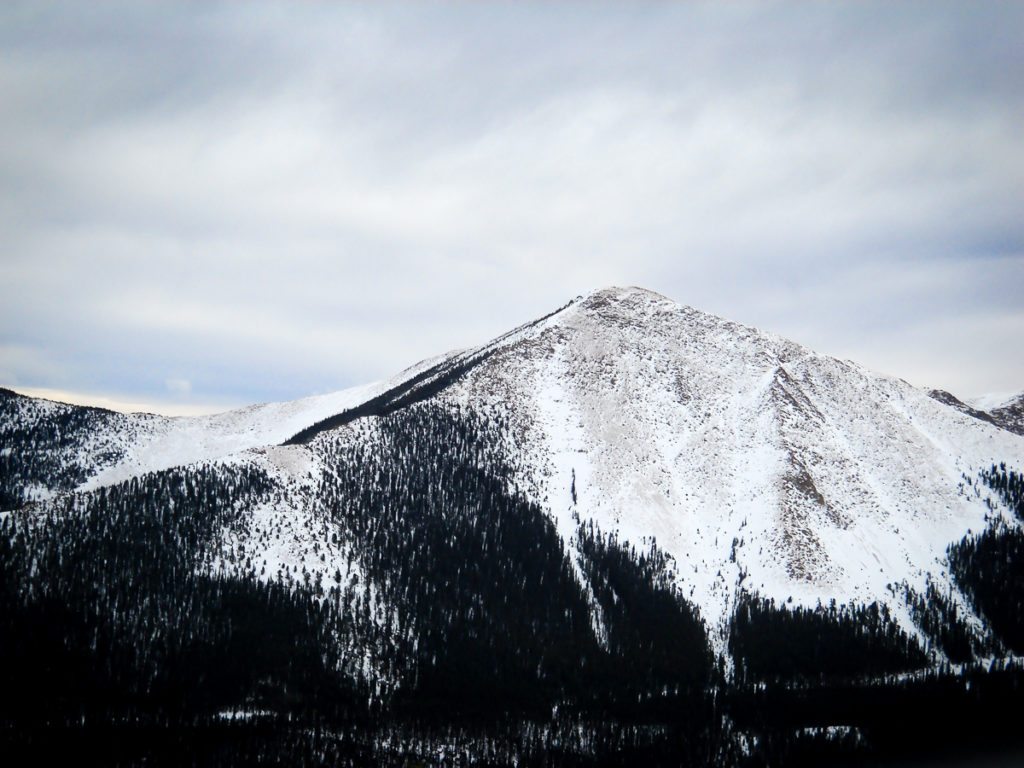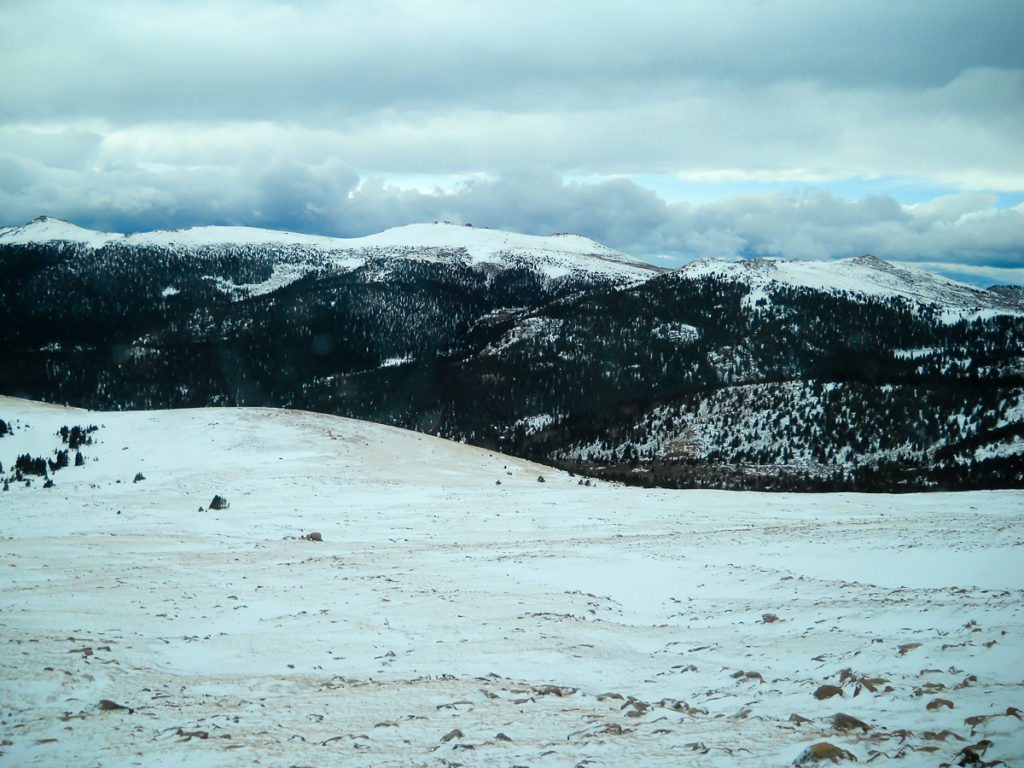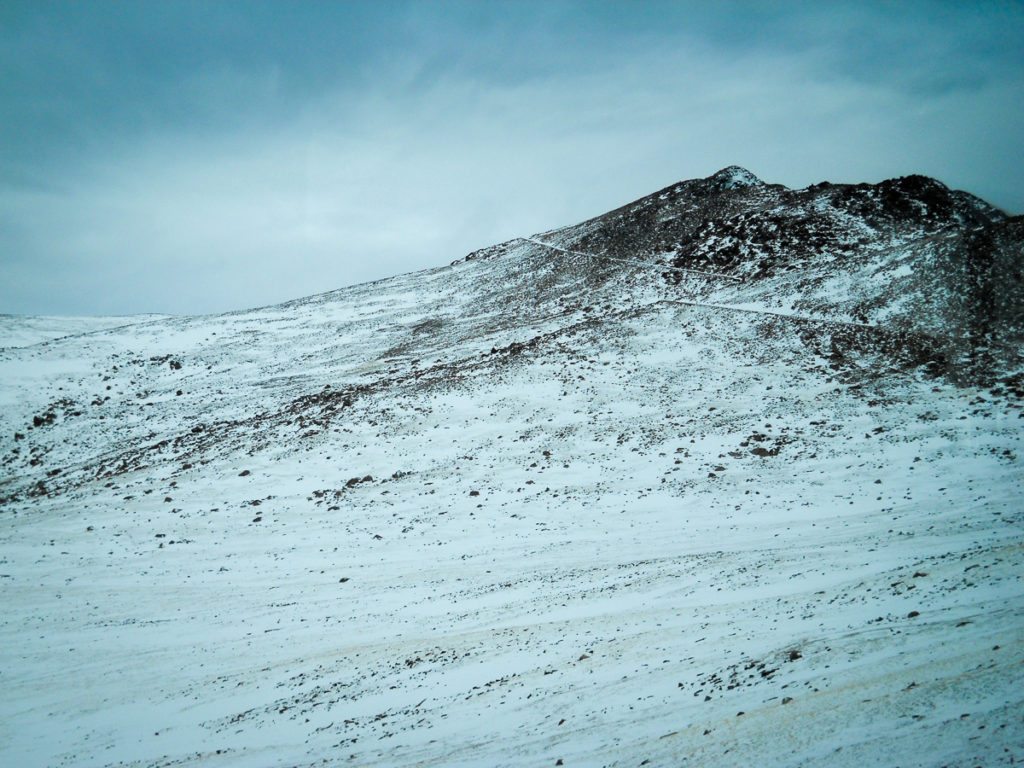View the Pikes Peak Photo Gallery. Turn on the captions to get the full story. Learn how at the Photo Galleries Guide.
Polar winds howl furiously across the rocky, snow-frosted summit. In the distance, a frozen pool of water fronts evergreen-stippled mountains lined up in a typical “M” mountain drawing formation. Beyond the bowl of the “M”, lies a vast emptiness that extends across Colorado into Kansas and New Mexico. It’s winter on Pikes Peak, the highest summit of the southern Front Range of the Rocky Mountains where panoramic views stretch out like rays of light all the way to the earth’s horizon.
At 14,115 feet, Pikes Peak is a Fourteener, a mountain peak with an elevation of at least 14,000 feet. There are 53 Fourteeners in the State of Colorado and 96 total Fourteeners in the U.S. On a world-wide scale, Pikes Peak is considered an ultra-prominent, one of 1,524 mountain summits on earth with a topographic prominence of 4,921’ or greater. Its prominence makes Pikes Peak a coveted notch on the belt of peak baggers, those hikers, mountaineers and others that attempt to scale mountain summits with prominent peaks, special features or that are located in particular regions.
Originally named El Capitan by early Spanish explorers, the summit was eventually re-named in honor of Zebulon Montgomery Pike. Pike was a lieutenant and later, a brigadier general, in the U.S. Army and an explorer. He led the Pike Expedition and in November 1806, he attempted to scale the mountain. Ironically, he never reached the summit which bears his name. His group only made it to Mount Rosa, which stands at 11,504 feet and lies southeast of Pikes Peak, before they became snowbound and, after two days without food, abandoned the climb.
“Pikes Peak or Bust” was emblazoned on the canvas of covered wagons during the gold rush of the late 1800’s. A prominent landmark, the mountain served as a beacon that guided gold prospectors westward over the Great Plains.
In 1895, eighty-nine years after Pike’s Expedition, America’s Mountain, as it is often called, inspired Katharine Lee Bates’ poem, “Pikes Peak”. In 1910, the poem was added as lyrics to Samuel A. Ward’s musical composition, “Materna” and the resulting anthem became “America the Beautiful”.
Today, explorers are still inspired to ascend the summit to enjoy the broad sweeping views from the vista. Some hike it, some bike it and some opt to reach the top of the mountain by sitting back and relaxing in cushioned seats on the Pikes Peak Cog Railway while gazing out of their windows at pastoral scenes of the Colorado landscape.
Cog railways, also called rack-and-pinion railways, are trains fitted with one or more cog wheels or pinions. As the train moves forward, the pinions interlock with toothed rack rails on steep grade railways, such as those on mountains, and prevent the train from sliding backwards.

Cog trains move forward as the pinions on their wheels engage and interlock with the black teeth on train rails.

The Halfway House was an early twentieth-century hotel located 6.27 miles up the 13-mile long mountain trail to the summit.
The Pikes Peak Cog Railway traverses 8.9 miles of track in 3 hours and 10 minutes. Along the way, it passes along Ruxton Creek in Englemann Canyon, Minnehaha Falls, Hell’s Gate, a natural gateway in the mountains, Deer Park, Four Mile Siding and Mountain View.
The train stops for 30-40 minutes at Summit House at the top of the mountain. If it stopped for any longer, passengers might experience the effects of altitude (slight nausea and headache), which can set in after about 30 minutes. Train riders should budget their time wisely to take in the breathtaking views, grab a snack, if desired, and take a bio break before hopping back on the train for the descent.
Weather permitting, hikers and bikers abound on the 13-mile one way, 26-mile round trip trail to the top of the mountain. Hikers can purchase a one-way train ticket to hike either up or down Pikes Peak. The tickets are only valid on the first or last train of the day, May through October on non-holidays. Learn more about riding the cog train as a hiker and visit Pikes Peak Country Attractions to learn more about hiking Pikes Peak.
Bikes are not allowed on the train but bicyclists can ride the train up to the summit and bike back down. Challenge Unlimited and Pikes Peak Mountain Bike Tours, not affiliated with the railway, offers these trips. More information about riding the cog train as a biker is available on the cog train website, including year-round trails, seasonal trails and epic rides.
For a unique group outing or special event, you can rent a 214-passenger train or 78-passenger train that comes complete with an engineer and conductor. Note that the railway requires full payment 2 weeks in advance of these scheduled trips.
Curious for a peek at the peak? You can catch a peek of the trainyard and mountains with only a one or two-minute real-time delay with the City of Colorado Springs Pikes Peak Camera and the Pikes Peak Yardcam. And, you can check the current weather conditions on Pikes Peak compared with Manitou Springs.
Good to Know Before You Go
- Weather conditions sometimes prevent the train from reaching the summit. Check the website or call first to avoid disappointment.
- Outside food and drinks cannot be brought on board the train. Food can be purchased at the Depot Market and taken on board. Limited food service may be available at the Summit House at the top of the mountain.
- There are no restrooms on the train. Restrooms are located on the ground at the Train Depot and the Summit House at the top of the mountain.
- Bring a jacket or sweater. The train is not heated although the engines underneath the train produce enough heat to maintain an interior temperature between 50 – 60 degrees. The summit has a polar climate because of its elevation and snowfall is a possibility year-round.
- According to the railway’s website, you must phone for same-day reservations if you need a wheelchair on the train, if you are hiking or want a one-way ticket (for example, if you are hiking either up or down the mountain or biking back down the mountain) or if you have a group of 16 or more.
- Parking is $5 per car and $20 for RVs. The City of Manitou Springs runs a free shuttle to the Cog Railway.
Deals and Discounts
- Coupons may be posted on the website, sometimes at the last minute to fill trains with empty seats.
- Railway customers may receive 10% off available rooms at the Cog Railway’s sister property, The Broadmoor Hotel, with a Cog Railway reservation. Call 719-577-5775 or 855-295-9944 to inquire.
Manitou & Pikes Peak Railway, 515 Ruxton Ave., Manitou Springs, CO 80829. Phone: 719-685-5401 or 800-745-3773. Website: www.cograilway.com. Email: info@cograilway.com. Google Directions. Downloadable Brochure.
View the Pikes Peak Photo Gallery. Turn on the captions to get the full story. Learn how at the Photo Galleries Guide.
References:
- This is a faithful photographic reproduction of a two-dimensional, public domain work of art. The work of art itself is in the public domain for the following reason: This work is in the public domain in its country of origin and other countries and areas where the copyright term is the author’s life plus 100 years or less.
- This file has been identified as being free of known restrictions under copyright law, including all related and neighboring rights. This work is in the public domain in its country of origin and other countries and areas where the copyright term is the author’s life plus 70 years or less.
- This work is in the public domain in the United States because it is a work prepared by an officer or employee of the United States Government as part of that person’s official duties under the terms of Title 17, Chapter 1, Section 105 of the US Code. See Copyright.


















